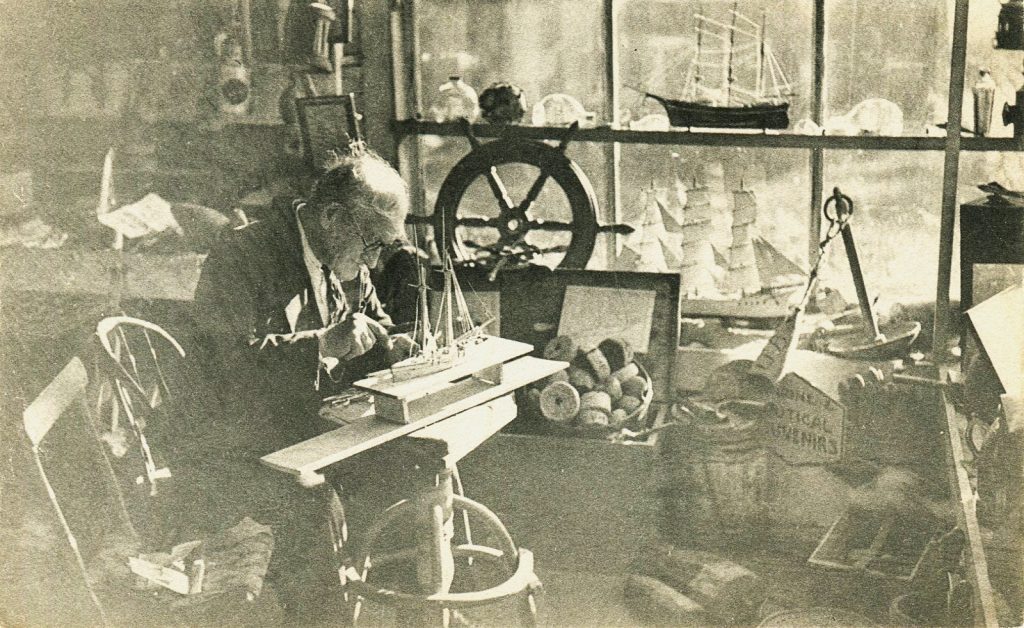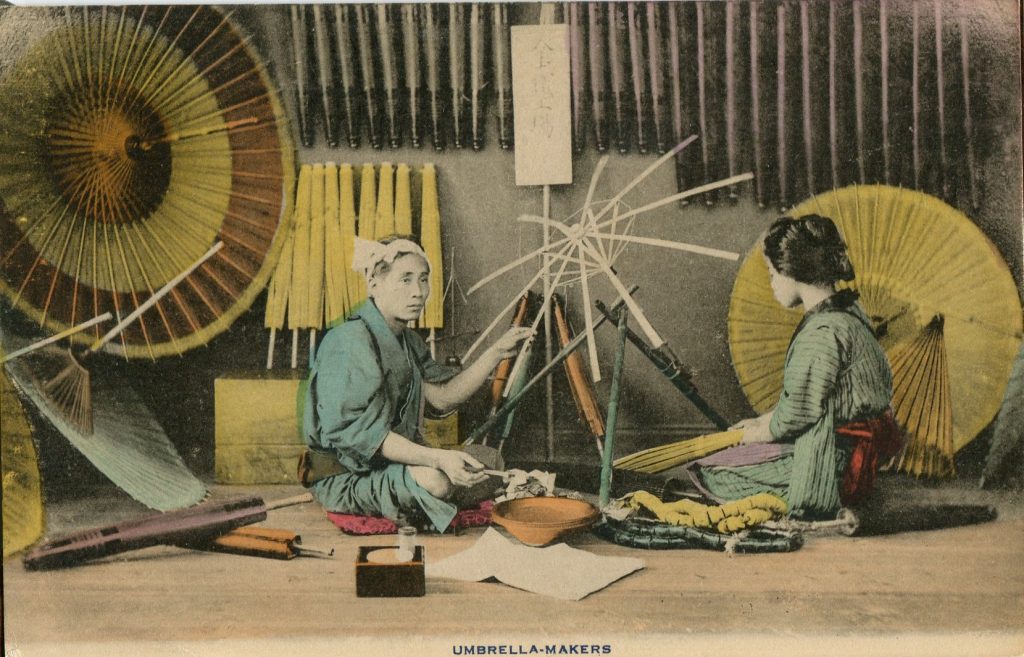Editor’s Staff
Occupations on Postcards
Women at Work
Part II
In the dusty old box where I found the Reader’s Digest that I mentioned in Part I, there were several hundred greeting cards. My friend’s great-grandmother must have saved everyone she received. Most of the early pieces were postmarked between 1902 and 1938. My curious nature finally got the best of me, so I asked if my friend knew when her great-grandmother was born. She didn’t remember, but thought it had to be prior to the Civil War. (A quick search on ancestry.com confirmed her guess. She was born in Baltimore, Maryland in 1851.)
There was nothing else of real interest except the album mentioned near the end of the piece. The page with the writing, captured my attention at once. I had heard the expression about “a laborer being worth his hire,” but had no idea that it came from the Bible.
The box was heavy – honestly, the box was so heavy that by the time I was a third of the way through the contents, it had stopped the circulation in my legs. I sat at first on a kitchen chair with the box on my lap. Won’t do that again.
My favorite postcard found among all that paper was this one. A model builder working at the window of his Parisian storefront. There are so many perfectly charming characteristics about it.

There is a life of experience etched in the face of the gentleman at work. There is determination, there is dedication, and abundant and remarkable craftsmanship.
The card was postmarked in Paris on September 9, 1914. Certainly, common sense tells us that the photograph on the card was taken long before the date it was mailed, but history was being made that day.
The German army was on its way to Paris and by that Wednesday they were but 18 miles from the Cathedral of Notre Dame. By the end of the week the British and the French had engaged with the Germans along the River Marne. As the battle raged one French general stationed in Paris ordered his reserve unit to the front lines, but he lacked sufficient means of transportation. Just four days before this card was mailed that same general requisitioned a thousand private vehicles and six hundred Parisian taxicabs and their drivers to transport his soldiers to the front.
Just imagine the chaos that must have raged in the streets. Trucks were unable to make deliveries, children couldn’t get to school, and men, and women too, couldn’t get to work. Just think how fascinating this collection would be if there were real photos of the ruckus taking place in the streets of Paris on that September day.
Part I of this two-part essay was easy to write, there were 47 postcards in the box and it was easy to select cards of men at work, to write about because of its scope. Part II is “Women at Work,” but there were only eleven to choose from. They are from places around the world, and like the Men at Work, those doing the labor are engaged in some fascinating occupations.

What a strange word “churning” is. It would seem to be an easy job, but it was a task not easily accomplished, especially by elderly women with arthritis in their hands, elbows, and shoulders. It wasn’t a slap-dash chore either. You had to have the cream at slightly more than room temperature. The plunge-and-draw (push-and-pull) of the dasher had to be done evenly to separate the butter from the milk fat. The average time needed was about a half-hour or slightly more. And that did not include the cleaning of the churn.
Have you ever tried doing the exact same body movement for a half-hour? Try it. It ain’t easy!

The scrub woman was someone who is good at any chore that required cleaning. Such ladies deserve our eternal gratitude, and those of Irish descent are the only ones ever celebrated in song. When the old Irish jig, The Irish Washerwoman was played on a violin or flute it was often an incentive to dance a jig and sing the crowd favorite.

Another seemingly easy job would be a tea-leaf picker. Not, so! In parts of India, on the Island of Ceylon, and many parts of Asia and Asia Minor young girls were sent to the tea fields to pick leaves, some as young as nine years old. They were trained by their mothers.
The work force was usually all females. They worked barefooted in rain or shine, usually from mid-morning to late afternoon. They got a two-hour break around noon.
Tea leaves are never cut, they are plucked with a twist and a tug. No metal instrument is used – ever. Supposedly, the flavor of a tealeaf changes when it comes in contact with a ferrous metal.
At the end of the day, the average tea picker will bring 68 to 75 pounds of tea leaves in from the plantation. Recently the names of tea producing areas have changed from “plantation” to “estate.”

Herring gutting. I have never met a herring gutter. Not even in Scotland. I’m unsure if that makes me lucky or under privileged.

It is turning into a routine to say, it was not an easy job, but one task that was exclusively women’s work was an orange blossom picker. From late March to late August of each year the ladders came out of the barns on southern French farms. The men would make needed repairs, i.e., replacing broken rungs or gluing split-side rails. The men would drag the ladders to the orchards for the women to begin work.
A team of workers (usually four to six women and two or three young boys) would “attack” each tree. A tree would be harvested at least twice each summer.
Landowners who owned orangeries would sell the blossoms to the perfume makers. The blossoms were used in bridal bouquets and wreaths put on doors of recent newlyweds. Orange-water was a favorite beverage throughout the Mediterranean as a replacement for rose-water. Another use was as a sweet substitute in Middle East and French cuisine and baked goods.

There is no place better to end than at the top. The two workers above are weaving silk into hats. A craft rarely seen outside of south-east Asia and centered in Manila. Look closely, atop the pile of silk thread at their feet, you will find two cylinders (one brown, one white) that are hat-forms (size unknown).
Silk hat weavers were once the highest paid crafters in all of Asia.

If you like working on intricate crafts and hat weaving doesn’t appeal to you consider becoming an umbrella maker. You get to spend your day cutting bamboo stalks into umbrella ribs and folding paper. After you shellac the paper canopies, you glue them across the open frames and trim the edges so the “tails” fold up at the end of each rib and get capped off with a sealing bead.
So, perhaps women’s work is more difficult than it appears.
As I type this, a maid who comes here every other week is cleaning my apartment. I’ve let her know several times how much I appreciate her efforts!
I found this article quite interesting as it ties in with a few of my favorite collections. For over 20 years, I have collected cards depicting people of other cultures – particularly people working, carrying heavy loads and cards that show women and young siblings carrying the young. I typically add anywhere from 20-30 cards a year and sometimes more, to my collections. Of all the cards pictured in your article, there is only one that I have in my collection – the elderly lady churning butter! At some point, I hope to find the others you shared! They would… Read more »
Dede–Appreciate your comments. Jon